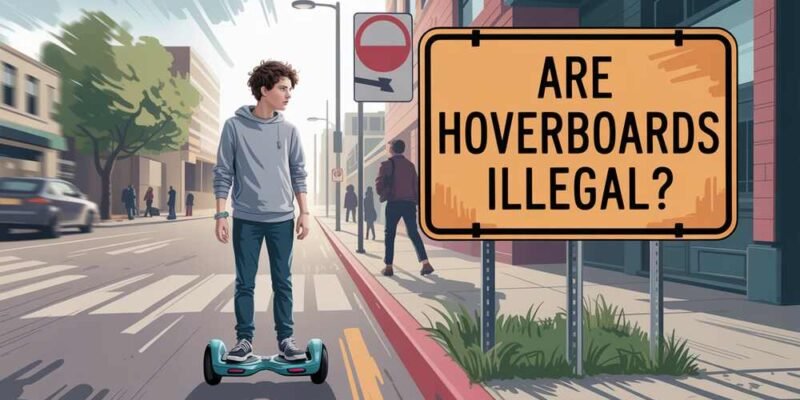Hoverboards, also known as self-balancing scooters, have quickly transitioned from a futuristic novelty to an everyday gadget in many homes. With their sleek design, intuitive control, and entertainment value, hoverboards continue to attract both children and adults. However, one pressing question often arises before purchase or use: Are hoverboards illegal?
This guide explores the legality of hoverboards where you can. It can’t ride them, and how to stay safe and compliant with relevant regulations — ensuring you make an informed choice before searching for the best hoverboards for sale.
What Are Hoverboards?
Hoverboards are two-wheeled, electric, self-balancing scooters powered by lithium-ion batteries. Riders control direction and speed by shifting their body weight. They’re commonly used for recreation, short-distance travel, or even as a lifestyle statement. Despite their popularity, hoverboards are often surrounded by confusion regarding their legality, particularly in public spaces.
Why the Legal Confusion?
Hoverboards fall into a grey area in many legal frameworks. They don’t quite meet the classification of a traditional vehicle, yet they are motorized and can travel at considerable speeds. This unique positioning makes them a topic of ongoing debate regarding public safety, insurance, and infrastructure readiness. This confusion leads to varying interpretations of the law, particularly regarding their use on pavements, roads, or cycle paths.
Are Hoverboards Illegal on Roads?
In many jurisdictions, hoverboards are not considered road-legal. This typically stems from the fact that they do not meet the minimum requirements for motor vehicles, such as:
1: Headlights or indicators
2: Registration or insurance
3: Type approval or certification
4: License plate display
5: Roadworthiness standards
Since hoverboards lack these essential features, they are often deemed unfit for public roadways. Law enforcement may treat their presence on roads as a violation of vehicle safety laws.
Key Takeaway:
If your local road regulations require vehicles to meet specific safety criteria, hoverboards will likely be disqualified from legal road use.
Can You Ride Hoverboards on Pavements or Sidewalks?
Many users assume pavements are a safe alternative to roads for riding hoverboards. However, in most areas, sidewalks or pedestrian walkways are not legally designated for motorized vehicles, which hoverboards technically are.
Even if they appear harmless, hoverboards can pose a hazard to pedestrians due to their weight and speed. As such, using them on public footpaths or pavements could lead to fines or other legal repercussions.
Important Consideration:
Local laws may view riding a hoverboard on the pavement as obstruction or endangerment of public space.
Where Are You Legally Allowed to Use Hoverboards?
Currently, the safest and most commonly accepted place to ride a hoverboard is on private property with the landowner’s permission. This could include:
1: Driveways
2: Private gardens
3: Indoor arenas
4: Warehouses
5: Private parks or recreational spaces
If you’re planning to use your hoverboard in any public or semi-public area, it’s essential to verify local regulations first or consult signage and property guidelines.
What Happens If You Ride One Illegally?
Using a hoverboard in a restricted area may result in various consequences, depending on how local laws are enforced. These might include:
1: Fines
2: Confiscation of the hoverboard
3: Written warnings
4: Penalty points or legal notices in extreme cases
While some areas may only issue verbal warnings, others take a more formal approach to discourage misuse in public places.
Are Hoverboards Banned Altogether?
It’s important to note that hoverboards are not banned entirely. Owning one is completely legal. The legal limitations typically pertain to where they can be used, not whether you can own or sell them. Therefore, buying a hoverboard is still an excellent option for use on private property, in indoor spaces, or at designated recreational facilities. Just make sure you understand the rules about where it can be used to avoid trouble. Are you looking to own one? Check out a curated range of hoverboards for sale from reputable and safety-certified sellers.
Hoverboard Safety and Certifications
Safety concerns have played a significant role in shaping public perception and legal restrictions. Early models of hoverboards were associated with issues like:
1: Fire hazards due to overheating batteries
2: Electrical short circuits
3: Unstable balancing systems
To address these, newer hoverboards now comply with strict safety certifications. If you’re considering buying one, look for these key safety features:
UL 2272 Certification
This is the industry standard for safe electrical systems in hoverboards. It verifies that the device has passed rigorous tests related to battery performance, electrical integrity, and temperature control.
Battery Management Systems (BMS)
Modern hoverboards feature built-in systems to prevent overcharging, overheating, and sudden shutdowns — enhancing safety and device longevity.
Rubber Foot Pads & LED Lighting
Added for improved grip, visibility, and user control, making hoverboards easier and safer to operate.
Tips for Safe and Responsible Hoverboard Use
Regardless of where you’re riding, always follow these safety best practices:
- Wear Protective Gear: A helmet, knee pads, elbow pads, and wrist guards are recommended, especially for beginners.
2: Check the Ground Surface: Avoid wet, slippery, or uneven surfaces that can cause accidents.
3: Practice First Indoors: Before taking your hoverboard outdoors, become comfortable with its responsiveness and turning radius.
4: Stay Visible: Use reflectors or LED lights during low visibility hours.
5: Obey Signage: Respect any signs indicating hoverboard restrictions in public or private spaces.
What to Look for When Shopping for a Hoverboard
With restrictions on public usage, it becomes even more important to purchase a hoverboard from a reputable seller. Features to prioritize include:
1: UL 2272 Certification
2: Powerful motor (250W–500W dual motors)
3: Long-lasting battery (minimum 2–3 hours runtime)
4: Rugged wheels for smooth performance
5: Bluetooth connectivity (optional for music lovers)
Buying from unknown or cheap sources might mean the device isn’t certified and could pose safety hazards. It’s always better to purchase from certified suppliers that offer warranties and customer support.
Final Verdict: Are Hoverboards Illegal?
The answer is nuanced. Hoverboards themselves are not illegal, but using them in unauthorized public spaces often is. Their classification as motorized transport means they’re subject to rules similar to those for electric scooters or mopeds, which can limit where you ride them legally. If you’re using your hoverboard on private property or in permitted recreational zones, you’re well within your rights. However, riding on roads, sidewalks, or public pathways without explicit legal allowance may result in fines or penalties.
Bottom Line:
Hoverboards are fun, modern devices that come with legal responsibilities. Understanding the law, staying safe, and choosing the correct riding location will help you enjoy your hoverboard without any unwanted surprises.
Looking to get started? Explore top-rated hoverboards for sale and make sure your next ride is fun, safe, and fully compliant.
Do Read: How Much Does CaseOh Weigh? Full Breakdown and Analysis













